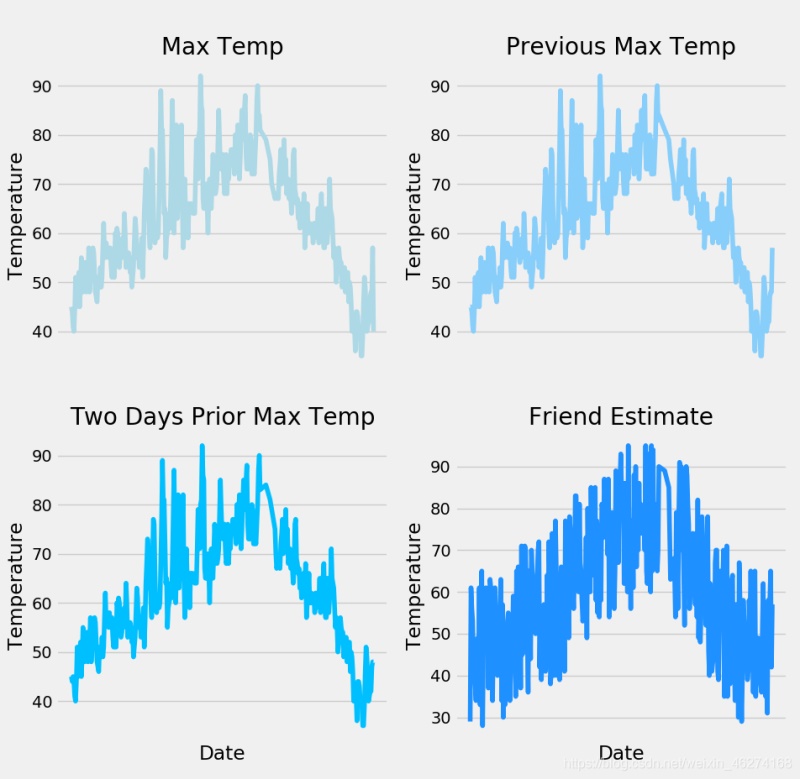概述
具体的案例描述在此就不多赘述. 同一数据集我们在机器学习里的随机森林模型中已经讨论过.
导包
import numpy as np import pandas as pd import datetime import matplotlib.pyplot as plt from pandas.plotting import register_matplotlib_converters from sklearn.preprocessing import StandardScaler import torch
数据读取
# ------------------1. 数据读取------------------
# 读取数据
data = pd.read_csv("temps.csv")
# 看看数据长什么样子
print(data.head())
# 查看数据维度
print("数据维度:", data.shape)
# 产看数据类型
print("数据类型:", type(data))
输出结果:
year month day week temp_2 temp_1 average actual friend
0 2016 1 1 Fri 45 45 45.6 45 29
1 2016 1 2 Sat 44 45 45.7 44 61
2 2016 1 3 Sun 45 44 45.8 41 56
3 2016 1 4 Mon 44 41 45.9 40 53
4 2016 1 5 Tues 41 40 46.0 44 41
数据维度: (348, 9)
数据类型: <class 'pandas.core.frame.DataFrame'>
数据预处理
# ------------------2. 数据预处理------------------
# datetime 格式
dates = pd.PeriodIndex(year=data["year"], month=data["month"], day=data["day"], freq="D").astype(str)
dates = [datetime.datetime.strptime(date, "%Y-%m-%d") for date in dates]
print(dates[:5])
# 编码转换
data = pd.get_dummies(data)
print(data.head())
# 画图
plt.style.use("fivethirtyeight")
register_matplotlib_converters()
# 标签
labels = np.array(data["actual"])
# 取消标签
data = data.drop(["actual"], axis= 1)
print(data.head())
# 保存一下列名
feature_list = list(data.columns)
# 格式转换
data_new = np.array(data)
data_new = StandardScaler().fit_transform(data_new)
print(data_new[:5])
输出结果:
[datetime.datetime(2016, 1, 1, 0, 0), datetime.datetime(2016, 1, 2, 0, 0), datetime.datetime(2016, 1, 3, 0, 0), datetime.datetime(2016, 1, 4, 0, 0), datetime.datetime(2016, 1, 5, 0, 0)]
year month day temp_2 ... week_Sun week_Thurs week_Tues week_Wed
0 2016 1 1 45 ... 0 0 0 0
1 2016 1 2 44 ... 0 0 0 0
2 2016 1 3 45 ... 1 0 0 0
3 2016 1 4 44 ... 0 0 0 0
4 2016 1 5 41 ... 0 0 1 0[5 rows x 15 columns]
year month day temp_2 ... week_Sun week_Thurs week_Tues week_Wed
0 2016 1 1 45 ... 0 0 0 0
1 2016 1 2 44 ... 0 0 0 0
2 2016 1 3 45 ... 1 0 0 0
3 2016 1 4 44 ... 0 0 0 0
4 2016 1 5 41 ... 0 0 1 0[5 rows x 14 columns]
[[ 0. -1.5678393 -1.65682171 -1.48452388 -1.49443549 -1.3470703
-1.98891668 2.44131112 -0.40482045 -0.40961596 -0.40482045 -0.40482045
-0.41913682 -0.40482045]
[ 0. -1.5678393 -1.54267126 -1.56929813 -1.49443549 -1.33755752
0.06187741 -0.40961596 -0.40482045 2.44131112 -0.40482045 -0.40482045
-0.41913682 -0.40482045]
[ 0. -1.5678393 -1.4285208 -1.48452388 -1.57953835 -1.32804474
-0.25855917 -0.40961596 -0.40482045 -0.40961596 2.47023092 -0.40482045
-0.41913682 -0.40482045]
[ 0. -1.5678393 -1.31437034 -1.56929813 -1.83484692 -1.31853195
-0.45082111 -0.40961596 2.47023092 -0.40961596 -0.40482045 -0.40482045
-0.41913682 -0.40482045]
[ 0. -1.5678393 -1.20021989 -1.8236209 -1.91994977 -1.30901917
-1.2198689 -0.40961596 -0.40482045 -0.40961596 -0.40482045 -0.40482045
2.38585576 -0.40482045]]
构建网络模型
# ------------------3. 构建网络模型------------------
x = torch.tensor(data_new)
y = torch.tensor(labels)
# 权重参数初始化
weights1 = torch.randn((14,128), dtype=float, requires_grad= True)
biases1 = torch.randn(128, dtype=float, requires_grad= True)
weights2 = torch.randn((128,1), dtype=float, requires_grad= True)
biases2 = torch.randn(1, dtype=float, requires_grad= True)
learning_rate = 0.001
losses = []
for i in range(1000):
# 计算隐层
hidden = x.mm(weights1) + biases1
# 加入激活函数
hidden = torch.relu(hidden)
# 预测结果
predictions = hidden.mm(weights2) + biases2
# 计算损失
loss = torch.mean((predictions - y) ** 2)
# 打印损失值
if i % 100 == 0:
print("loss:", loss)
# 反向传播计算
loss.backward()
# 更新参数
weights1.data.add_(-learning_rate * weights1.grad.data)
biases1.data.add_(-learning_rate * biases1.grad.data)
weights2.data.add_(-learning_rate * weights2.grad.data)
biases2.data.add_(-learning_rate * biases2.grad.data)
# 每次迭代清空
weights1.grad.data.zero_()
biases1.grad.data.zero_()
weights2.grad.data.zero_()
biases2.grad.data.zero_()
输出结果:
loss: tensor(4746.8598, dtype=torch.float64, grad_fn=<MeanBackward0>)
loss: tensor(156.5691, dtype=torch.float64, grad_fn=<MeanBackward0>)
loss: tensor(148.9419, dtype=torch.float64, grad_fn=<MeanBackward0>)
loss: tensor(146.1035, dtype=torch.float64, grad_fn=<MeanBackward0>)
loss: tensor(144.5652, dtype=torch.float64, grad_fn=<MeanBackward0>)
loss: tensor(143.5376, dtype=torch.float64, grad_fn=<MeanBackward0>)
loss: tensor(142.7823, dtype=torch.float64, grad_fn=<MeanBackward0>)
loss: tensor(142.2151, dtype=torch.float64, grad_fn=<MeanBackward0>)
loss: tensor(141.7770, dtype=torch.float64, grad_fn=<MeanBackward0>)
loss: tensor(141.4294, dtype=torch.float64, grad_fn=<MeanBackward0>)
数据可视化
# ------------------4. 数据可视化------------------
def graph1():
# 创建子图
f, ax = plt.subplots(2, 2, figsize=(10, 10))
# 标签值
ax[0, 0].plot(dates, labels, color="#ADD8E6")
ax[0, 0].set_xticks([""])
ax[0, 0].set_ylabel("Temperature")
ax[0, 0].set_title("Max Temp")
# 昨天
ax[0, 1].plot(dates, data["temp_1"], color="#87CEFA")
ax[0, 1].set_xticks([""])
ax[0, 1].set_ylabel("Temperature")
ax[0, 1].set_title("Previous Max Temp")
# 前天
ax[1, 0].plot(dates, data["temp_2"], color="#00BFFF")
ax[1, 0].set_xticks([""])
ax[1, 0].set_xlabel("Date")
ax[1, 0].set_ylabel("Temperature")
ax[1, 0].set_title("Two Days Prior Max Temp")
# 朋友
ax[1, 1].plot(dates, data["friend"], color="#1E90FF")
ax[1, 1].set_xticks([""])
ax[1, 1].set_xlabel("Date")
ax[1, 1].set_ylabel("Temperature")
ax[1, 1].set_title("Friend Estimate")
plt.show()
输出结果:

完整代码
import numpy as np
import pandas as pd
import datetime
import matplotlib.pyplot as plt
from pandas.plotting import register_matplotlib_converters
from sklearn.preprocessing import StandardScaler
import torch
# ------------------1. 数据读取------------------
# 读取数据
data = pd.read_csv("temps.csv")
# 看看数据长什么样子
print(data.head())
# 查看数据维度
print("数据维度:", data.shape)
# 产看数据类型
print("数据类型:", type(data))
# ------------------2. 数据预处理------------------
# datetime 格式
dates = pd.PeriodIndex(year=data["year"], month=data["month"], day=data["day"], freq="D").astype(str)
dates = [datetime.datetime.strptime(date, "%Y-%m-%d") for date in dates]
print(dates[:5])
# 编码转换
data = pd.get_dummies(data)
print(data.head())
# 画图
plt.style.use("fivethirtyeight")
register_matplotlib_converters()
# 标签
labels = np.array(data["actual"])
# 取消标签
data = data.drop(["actual"], axis= 1)
print(data.head())
# 保存一下列名
feature_list = list(data.columns)
# 格式转换
data_new = np.array(data)
data_new = StandardScaler().fit_transform(data_new)
print(data_new[:5])
# ------------------3. 构建网络模型------------------
x = torch.tensor(data_new)
y = torch.tensor(labels)
# 权重参数初始化
weights1 = torch.randn((14,128), dtype=float, requires_grad= True)
biases1 = torch.randn(128, dtype=float, requires_grad= True)
weights2 = torch.randn((128,1), dtype=float, requires_grad= True)
biases2 = torch.randn(1, dtype=float, requires_grad= True)
learning_rate = 0.001
losses = []
for i in range(1000):
# 计算隐层
hidden = x.mm(weights1) + biases1
# 加入激活函数
hidden = torch.relu(hidden)
# 预测结果
predictions = hidden.mm(weights2) + biases2
# 计算损失
loss = torch.mean((predictions - y) ** 2)
# 打印损失值
if i % 100 == 0:
print("loss:", loss)
# 反向传播计算
loss.backward()
# 更新参数
weights1.data.add_(-learning_rate * weights1.grad.data)
biases1.data.add_(-learning_rate * biases1.grad.data)
weights2.data.add_(-learning_rate * weights2.grad.data)
biases2.data.add_(-learning_rate * biases2.grad.data)
# 每次迭代清空
weights1.grad.data.zero_()
biases1.grad.data.zero_()
weights2.grad.data.zero_()
biases2.grad.data.zero_()
# ------------------4. 数据可视化------------------
def graph1():
# 创建子图
f, ax = plt.subplots(2, 2, figsize=(10, 10))
# 标签值
ax[0, 0].plot(dates, labels, color="#ADD8E6")
ax[0, 0].set_xticks([""])
ax[0, 0].set_ylabel("Temperature")
ax[0, 0].set_title("Max Temp")
# 昨天
ax[0, 1].plot(dates, data["temp_1"], color="#87CEFA")
ax[0, 1].set_xticks([""])
ax[0, 1].set_ylabel("Temperature")
ax[0, 1].set_title("Previous Max Temp")
# 前天
ax[1, 0].plot(dates, data["temp_2"], color="#00BFFF")
ax[1, 0].set_xticks([""])
ax[1, 0].set_xlabel("Date")
ax[1, 0].set_ylabel("Temperature")
ax[1, 0].set_title("Two Days Prior Max Temp")
# 朋友
ax[1, 1].plot(dates, data["friend"], color="#1E90FF")
ax[1, 1].set_xticks([""])
ax[1, 1].set_xlabel("Date")
ax[1, 1].set_ylabel("Temperature")
ax[1, 1].set_title("Friend Estimate")
plt.show()
if __name__ == "__main__":
graph1()
到此这篇关于PyTorch一小时掌握之神经网络气温预测篇的文章就介绍到这了,更多相关PyTorch 神经网络气温预测内容请搜索服务器之家以前的文章或继续浏览下面的相关文章希望大家以后多多支持服务器之家!
原文链接:https://blog.csdn.net/weixin_46274168/article/details/114176589










